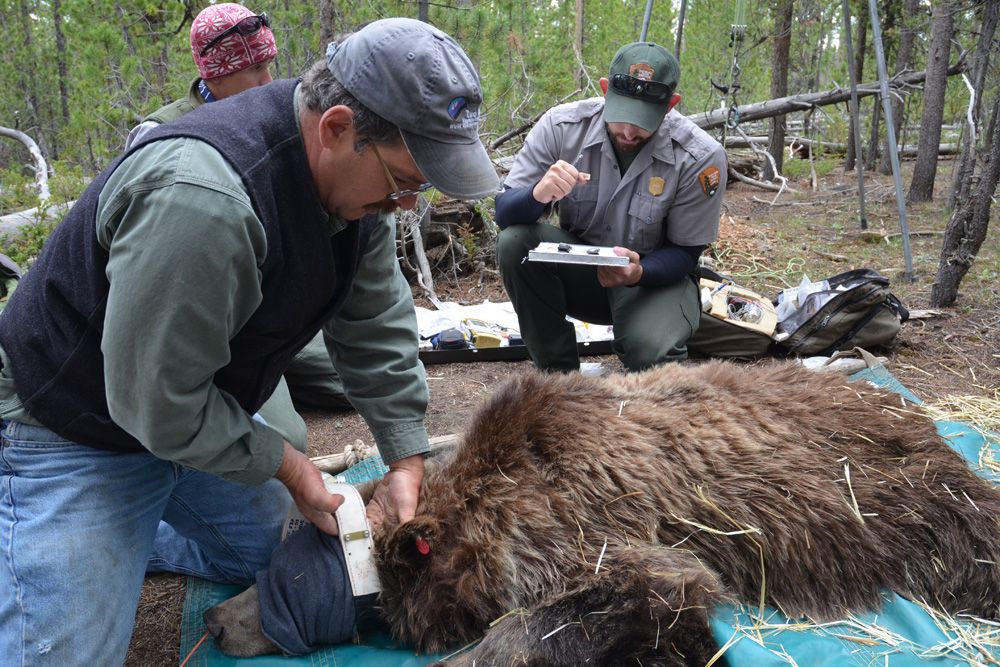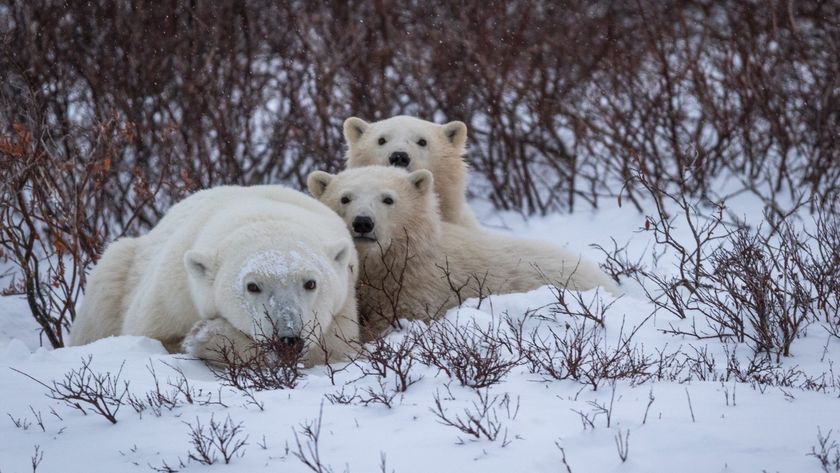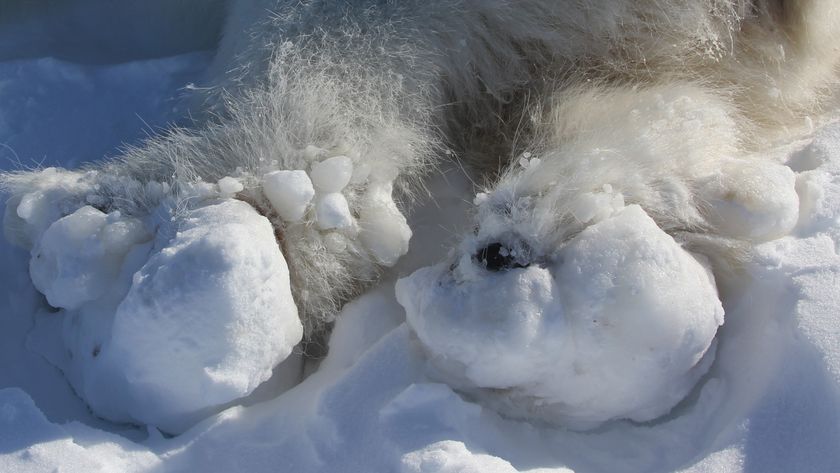Grizzlies Should Stay on Endangered Species List, Scientists Say

Yellowstone National Park grizzly bears could be removed from the Endangered Species list after a new federal report revealed that the bears are not threatened by the loss of one of their main foods, whitebark pine nuts.
But outside scientists are criticizing the report, calling it incomplete, politically motivated and flawed.
"It does not take into account the situation, the realities of the conditions on the ground in whitebark pine forests," said Jesse Logan, the retired head of the U.S. Forest Service's bark beetle research unit. Whitebark pines are increasingly falling victim to mountain pine beetles, which kill trees in the process of laying their eggs under the bark. Climate change has made the high-elevation whitebark pines more accessible to the destructive beetles.
Bear battle
The fight over the delisting of the Yellowstone grizzly population is a years-long saga. The bears were temporarily removed from the Endangered Species list in 2007, after the U.S. Fish and Wildlife Service (USFWS) declared that the animals' numbers had recovered sufficiently not to need federal protection. In 2009, a federal district court in Montana overturned the delisting, bumping the grizzlies back to protected status. The judge cited concerns that the USFWS had failed to consider the decline in whitebark pine in its decision. [Images: Trapping Yellowstone's Grizzlies]
In recent years, the growth of Yellowstone's grizzly population has slowed or possibly declined. Part of the challenge of tracking the population's health is figuring out if this slowing is because bears are so crowded in their habitat that older bears are killing cubs, or if the slow-down is related to food scarcity.
Bears rely on four major food sources in the Yellowstone region, said David Mattson, a visiting senior research scientist and lecturer at Yale University who studied the grizzlies for more than a decade as a U.S. Geological Survey scientist. One is calorie-rich whitebark pine nuts. Yellowstone bears also eat cutthroat trout, meat from elk and bison, and a fatty, high-elevation insect called the army cutworm moth.
Sign up for the Live Science daily newsletter now
Get the world’s most fascinating discoveries delivered straight to your inbox.
Pine nuts in particular are linked to birth and death rates, Mattson said in a press conference organized by the Union of Concerned Scientists, an advocacy group for science in public politicy.
"When female bears, in particular, eat more pine seeds, they give birth to more cubs, and they die at a lesser rate," Mattson said.
The new recommendations to delist come to the USFWS from the Yellowstone Ecosystem Subcommittee of the Interagency Grizzly Bear Committee. According to a new federal report presented to the committee this week, bear health is not linked to the availability of whitebark pine nuts.
Whitebark controversy
Mattson and other outside scientists strongly contest those findings. The report downplays a published decline in grizzly bear fat composition dating to about 2006, when the impact of the loss of the whitebark pine started to be felt, Logan said. The USFWS was ill-prepared to track the outbreak of the beetle infestation, Logan told reporters during a press briefing today (Dec. 12). When the agency first delisted the grizzly bear from the Endangered Species list in 2007, it estimated that 16 percent of the whitebark pine in the habitat had been affected by beetles. The sea of dead trees along ridgelines called that number into serious doubt, Logan said.
"We were able to launch a study in the summer of 2009 to measure the impact of mountain pine beetles in whitebark pine," he said. "What we found was, rather than 16 percent had been impacted at some level, 95 percent had been impacted."
The new report continues to paint a too-rosy picture, Logan said. The central habitat of the grizzlies is among the hardest-hit in the beetle epidemic, he said. And contrary to implications in the report, the infestation does not appear to be waning.
The interagency committee "has a history of first denying what was occurring in whitebark and then underestimating, or in fact, misleading, the impact of the loss," Logan said.
Habitat trouble
Mattson and Logan further criticized the bear report for downplaying the links between pine nuts and grizzly health. Nor did the federal scientists expand their study beyond pine nuts, Mattson said. Evidence suggests that bears, especially females, are eating more meat to compensate for the loss of whitebark pine nuts. Meat provides plenty of calories, but it comes with a side of danger. Cubs and yearlings at a kill site are more likely to be killed by wolves or older bears than are cubs and yearlings snuffling for pine nuts. And meat-eating puts adult bears into closer contact with human hunters – and ranchers, should they go after livestock. [8 Ways Global Warming is Already Changing the World]
The result has been an increase both in total number of bear deaths and in the proportion of bears killed by humans, Mattson said.
Meanwhile, cutthroat trout are in decline, because of predation by a non-native fish.
"There is not a single positive trend afoot in Yellowstone's grizzly bear habitat," Mattson said.
Compounding the problem, Mattson said, is the fact that many of the studies in the federal report recommending delisting have not undergone review by outside scientists or have not been published in scientific journals, a crucial step in validating scientific research.
What's next for grizzlies
Keeping the grizzly bear on the endangered species list would provide one ray of hope in a bad situation, Mattson said: It would keep states from opening up hunting season on the bear.
"One of the first things the states are going to do is, in fact, institute a sports hunt," Mattson said. "They've said so."
Delisting grizzlies would also allow states more freely to kill bears that became a nuisance to livestock — a real concern in a time when bears and ranchers are clashing more frequently.
Federal protection "makes it more likely that bears can continue to spread out into areas we know are suitable for bears," Mattson said. A wider range could bring the Yellowstone population in contact with other grizzly populations, making all of the populations less vulnerable in the long haul.
The USFWS is not mandated to follow the committee recommendations, but it is likely to do so, said Kristin Carden, an attorney with Earthjustice, an environmental advocacy group. The next step in the process is for the agency to draft a delisting plan, with input from the Department of the Interior and the Department of Justice. Next, the plan would be open to public comment. Review of the studies used in the report or public outcry could alter the trajectory toward delisting, Carden told reporters. The final option is for organizations such as Earthjustice to file a lawsuit against the USFWS to prevent the delisting.
Whatever happens, Yellowstone grizzlies face extraordinary challenges as climate change drives the loss of habitat and food sources.
"What we have is a habitat fabric that is simply unraveling," Mattson said.
Follow Stephanie Pappas on Twitter and Google+. Follow us @livescience, Facebook & Google+. Original article on LiveScience.

Stephanie Pappas is a contributing writer for Live Science, covering topics ranging from geoscience to archaeology to the human brain and behavior. She was previously a senior writer for Live Science but is now a freelancer based in Denver, Colorado, and regularly contributes to Scientific American and The Monitor, the monthly magazine of the American Psychological Association. Stephanie received a bachelor's degree in psychology from the University of South Carolina and a graduate certificate in science communication from the University of California, Santa Cruz.











